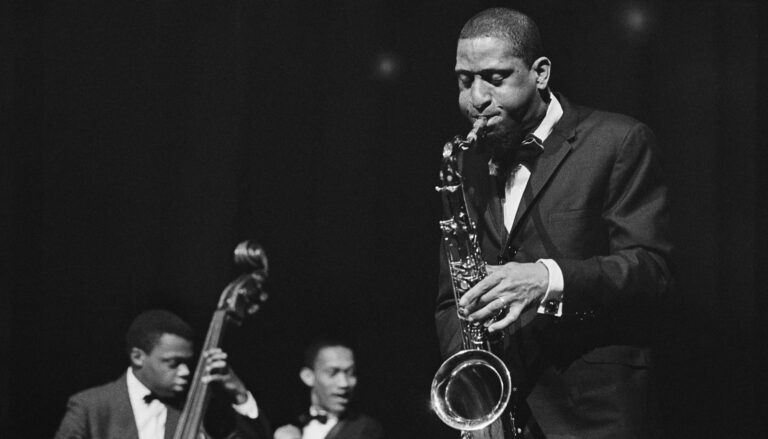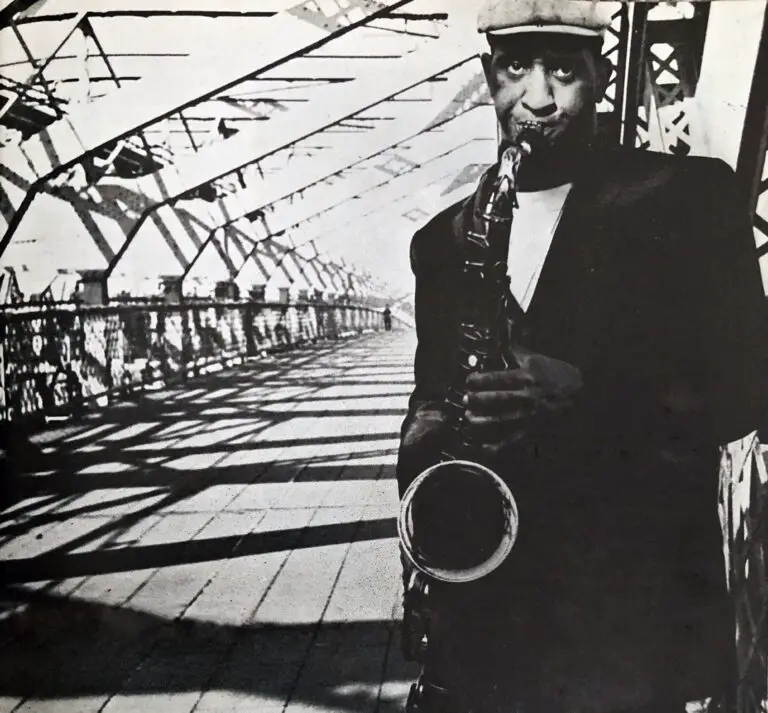In his new book, Saxophone Colossus: The Life and Music of Sonny Rollins, author Aidan Levy has created a work nearly as sprawling and monumental as the seven-decades of sounds crafted by a man widely considered “jazz’s greatest living improviser.”

Levy devoted seven years to the task of capturing Rollins – the musician, the myth, the civil rights activist, environmentalist and wandering spiritualist – in a whopping 750 very readable pages. The book is based on more than 200 interviews with Rollins, his family members, friends and collaborators, as well as the artist’s personal archive of letters, journals, photos and press clippings accrued over a career in which he has taken a few notable sabbaticals and sharp stylistic turns. It pretty much traces every recording session and gig that the Saxophone Colossus participated in. The depth of Levy’s astounding research is furthered by the more than 400 pages of footnotes available only online (including my story for NYSMusic on his legendary concert at Opus 40 in Saugerties).
I’m a pretty fast reader but I spent close to three months with Levy’s book. It was devoted to toggling between deep reading and deeper listening to the many corners of Rollins’ 60 solo and live albums, and the multitude of classics on which he guested with Miles Davis, Thelonious Monk, Clifford Brown and the like.
Rollins was a child of the Harlem Renaissance. Inspired by his Sugar Hill neighbor, tenor great Louis Jordan, he picked up the sax at 8 and landed, beginning as a teenager, on the bandstand and in the recording studio with greats like Bud Powell, Charlie Parker, Miles Davis and Dizzy Gillespie. His youthful exposure to the Calypso music of his familial roots in the West Indies and love of classic Hollywood movies would bear fruit later in his career in respective classics like “St. Thomas” and “I’m An Old Cowhand.” With drawn-on moustaches, he and his original band formed while attending Franklin High, the Counts of Bop featuring Art Taylor, Walter Bishop, Jackie McLean and Kenny Drew, would head to Minton’s or the phalanx of jazz clubs on 52nd St to watch and hopefully be invited to sit-in with idols like Coleman Hawkins.

Sonny’s passion for civil rights and justice was shaped by two early events. The first was his military-lifer father’s court martial and jailing for the crime of “teaching a white woman to dance” at an officer’s party he was managing, an event that made national headlines. The second was his own experiences in the criminal justice system. This latter was the result of his and his musician pals’ heroin addictions, something plied in a Harlem park they called “Goof Square.” Rollins would do two stretches on Riker’s Island for pickpocketing and a gun charge. It was during a stint at that jail in 1954, while playing in the Protestant chapel band, that Rollins penned three of his much-covered classics, “Airegin,” “Doxy” and “Oleo.”
In 1955, Rollins turns his life around by starting to kick junk after a stay in Lexington, the famous prison/rehab facility, and a move to Chicago and legendary collaboration with the Max Roach/Clifford Jordan. He would stay clean working day jobs as a porter, door-to-door salesman and janitor in Chicago. It’s also the city where he would meet his second wife and manager Lucille.
In 1956, Rollins begins what may be one of the most critically acclaimed and productive runs in jazz history, waxing ten astounding classic albums, six as leader including his twin masterworks, “Tenor Madness” and “Saxophone Colossus.” He would conjure nine additional solo classics in 1957 and 1958 including “Way Out West,” “Newk’s Time” and “Freedom Suite.”
For these and the dozens of albums that followed, Levy gives a blow-by-blow on the sessions. He details the careful selection of sidemen and the sometimes dozen-plus takes Rollins would record before hitting on something that met, maybe, his insanely perfectionist standards.
While by this time he was finally being accorded the acclaim he deserved, the revelation in Levy’s book is how savagely he was treated by critics like Leonard Feather in earlier solo discs and in sessions with Miles Davis and others.
A great deal of the myth around Sonny Rollins has been predicated on his sabbaticals from the world of music, ones taken because he didn’t think he was “good enough.” The most legendary was the one from 1959 – 1961 when Rollins would walk from the apartment he shared with Lucille on Grand Street to the Williamsburg Bridge, where he would play for 15 hours – day and night – to the skyscrapers and ships passing in the harbor below. This sabbatical, and another in India in 1968, weren’t only about music. During these times, Rollins explored various religions like Rosicrucianism, anthropology and sociology. He also became deeply committed to nutrition and fitness, practicing Hatha Yoga, juicing and vegetarian diets and weight lifeting. Later on, Rollins would travel the world with a suitcase full of dumbbells, something that was impossible for any of his bandmates to lift. Rollins’ devotion to fitness even earned him a place on JFK’s Fitness Committee.
Great light is shed on Rollins’ methodology and inner thoughts, and those of his Swife/manager Lucille, in the many diaries and letters Levy was granted access too. Sonny seemed to forever be trying to commit his practice methodology, mixed with life and spiritual lessons, in a never-finished book he sometimes titled “Saxophone Energy & Health.”
A scourge that returned repeatedly to hamper Rollins’ playing and career were his dental problems, which made playing his marathon live sets nearly impossible. On many nights, he just played through the pain, creating a brand of improvisatory ecstasy that he may never have felt was properly captured on disc.

Another thing that is evident in Levy’s book is Rollins never-ending quest for the right group of musicians. Sonny would fire folks in the middle of sets, actually firing his whole band, one by one, during the opening night of a run at the Village Vanguard. It wasn’t personal; he was always looking for the right mix, and players who were fired, would often be asked to return.
Levy devotes a great deal of time to Sonny’s classic eras like his return in 1961 in a quartet, donning a Mohawk haircut, with guitarist Jim Hall, a configuration which yielded albums like “The Bridge.” Levy also discusses Sonny’s writing and recording of the soundtrack to the classic British film, “Alfie.”
As someone who has seen Sonny live numerous times and listened to a lot of his discography, I, like many, kind of brushed aside Rollins’ so-called fusion period of 1970s. Levy’s book made me come to appreciate a lot of the great work on these later albums, the Herbie Hancock Headhunters-inspired “Nucleus” and “Next Album.” The author also sheds light on Rollins’ guesting with The Rolling Stones on “Tattoo You.” He didn’t know who they were and didn’t really want to be a part but Lucille insisted, knowing it would heighten his profile with younger music fans. He made the overdub session, waxing ballsy one-take solos on tracks including “Waiting On A Friend” and the blazing jam “Slave.” But when they came with a cool million in hand asking him to join them on the road, Sonny said “nyet” because rock was “below jazz.”
Levy takes us up to the present with Sonny’s story. In the beginning on the 2000s, he sees many of his contemporary and collaborators – Miles, Monk, Dizzy, etc. – slip the mortal coil. We hear all about the legendary gig at Opus 40 where he breaks a heel jumping off the stone monument stage then continues to finish the concert, drama immortalized in the “Saxophone Colossus” documentary. I had the pleasure of seeing Sonny on his next gig on a Hudson River cruise boat, where he played a steaming, three-hour set seated in a lounge chair with his wounded foot elevated. It was one of the top three gigs of my lifetime. I was also lucky enough to catch another gig detailed in the book, Sonny’s 80th Birthday show at the Beacon Theater. Here he reunited with past collaborators like Jim Hall and Roy Haynes and played, for the first-time on stage, with Ornette Coleman.
Ahh, the interesting sidebars and detours. While not central to the story, Levy shares reams of gee-whiz history/trivia. In a discussion of Rollins’ island-inspired classics, he shares how Nation of Islam leader Lewis Farrakhan and novelist Maya Angelou first gain notoriety. It was as calypso singers, The Charmer and Miss Calypso respectfully. We hear how Dave Brubeck’s sax man Paul Desmond turns Sonny on the wonders of Pepto-Bismol and of the multi-faceted life of Babs Gonzales. Babs was a vocalist/poet/author/promoter/proto-hipster and global playboy with whom Sonny made his recording debut in 1949.
Sonny finds peace with a move to a farm in Germantown, N.Y, where he will take only the best live gigs, with Lucille minding the business, including touring and record production. In 2001, he will finally win a Grammy for Best Jazz Instrumental album.
Also in 2001, Sonny becomes another victim of 9/11. Rollins was in his pied-a-terre six blocks from the World Trade Center at the time of the tragedy. Possibly due to his inhalation of toxic dust from the site in the day it took him to evacuate, Sonny develops pulmonary fibrosis. In 2004, Sonny’s wife Lucille passes. In 2012, he plays his last concert in Barcelona. Also, that year, he moves to Woodstock, where he remains being looked in on by friends like drummer Jack DeJohnette and his wife.
In 2014 due to his lung condition, Sonny totally quits playing sax. He stays busy with his reading and study of things maybe far greater than jazz. He believes in reincarnation and tells his dying collaborators that he will just catch them at the next gig in whatever world comes next.
Levy’s book is a wonderful detailed and insightful journey through the life of an incredible artist and thinker. It is unlikely anyone will pen anything about Rollins, and maybe any other jazz musician, that will be its equal.


Comments are closed.